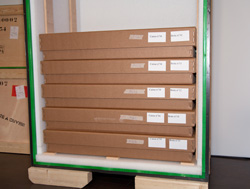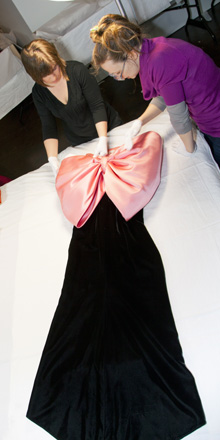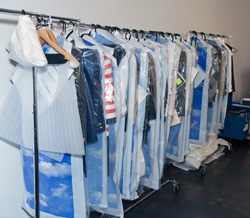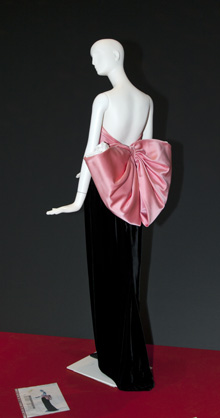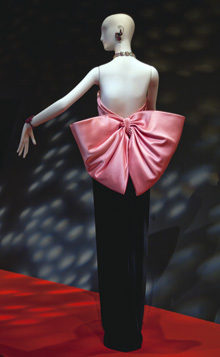Yves Saint Laurent: The Retrospective successfully opened at the Denver Art Museum on March 25. However, behind-the-scenes installation activities for this exciting exhibition began weeks before. An installation team consisting of Fondation Pierre Bergé-Yves Saint Laurent personnel with contracted specialists arrived from Paris on March 7th to begin installation on March 8th. The DAM provided its own installation team including registrars, collection managers, installation specialists, preparators, and conservators. The team also included a number of invaluable volunteers and interns, known as stagiaires in French, from the Denver area.
The role of the conservators was to ensure that the various items in the exhibition were carefully uncrated, thoroughly examined for condition, and treated and stabilized if required. Conservators also assisted with dressing and accessorizing the mannequins displaying the 200 haute couture ensembles.
Below, follow Yves Saint Laurent’s iconic black velvet sheath dress with large pink satin bow through the unpacking and installation process. Every one of the 1,500 objects comprising the exhibition were processed the same way.
Unpack crate: The dress was packed in a sturdy, lidded box within a crate housing a number of other boxes. Once the lid of the box was removed, it was evident that the dress was carefully packed and protected from movement during transport. It was placed on a bed of acid-free tissue paper rolls under the whole length of the piece. Several more rolls of tissue of varying lengths and thicknesses were used to pad and support folds, creases, seams and pleats throughout the dress and bow. Finally, large sheets of tissue paper covered all. The dress was removed carefully and placed on a padded and covered table to be assessed for condition.
Condition assessment: The dress was assessed for condition by one of the Fondation team members together with DAM conservators and registrars. Each object has detailed photographic and written documentation outlining the condition of the piece. Condition assessment involves thoroughly examining the item to evaluate structural and surface stability as well as to note past damages and repairs and any current need for treatment. The object is compared with the condition report and photographs to determine if any change has occurred to the item in transit. This is a time consuming process as every inch (or centimeter!) must be viewed and assessed. When the dress is deinstalled, it will undergo the same condition assessment process.
Hanging and Transporting to Galleries: Once examination was complete, a stagiaire placed the piece on a hanger padded with acid-free tissue, covered it for dust protection and hung it on a wheeled clothes rack with its documentation. Once filled, the racks were transported to their designated galleries.
Dressing Mannequins: The mannequins arrived at the DAM disassembled in several crates. DAM installation specialists assembled each mannequin. A very thick instruction manual accompanied the mannequins in order to build them in the correct stances. In most cases, the mannequins had to be partially disassembled to dress them. For example, the arms had to be removed from the mannequin sporting the black velvet sheath dress with pink satin bow. Lower bodies and legs were removed and fitted with pantyhose and shoes before being dressed with trousers, skirts, shorts or dresses.
Many mannequins also were padded before dressing them. Under the direction of DAM conservators, stagiaires made polyester batting sleeves to pad arms and leg inserts to support the sharp front creases of trousers.
A specific photograph of each ensemble provided by the Fondation was essential in order to accessorize the mannequins. Bracelets, earrings, necklaces, scarves, veils, hats, and hairpieces were placed according to the photograph and secured.
Final adjustments: Final adjustments to the mannequins could be as simple as retying a bow or changing the tilt of a hat or could involve more complex repositioning of the mannequins or adjustments to lighting. For instance, the black velvet sheath dress with satin pink bow was subtly repositioned several times before the placement was finalized. This crucial final step of the installation was undertaken by the curator of the exhibition and a consultant who had worked for Yves Saint Laurent at his fashion house in Paris for 40 years. She was present to bring his “essence” to the show. M. Pierre Bergé himself arrived before the big opening, reviewed the installation and gave his final approval for all.
The installation of such a large and complex exhibition has many moving parts. The conservation department played a crucial role in the exhibition and will continue to monitor these exquisite items on display until it is deinstalled after the July 8 closing and we start all over again–in reverse!
You can hear more stories about preparations for bringing Yves Saint Laurent: The Retrospective to life at the DAM on April 26 at Tattered Cover in Historic LoDo. DAM associate director of collection services Jill Desmond will share highlights.

